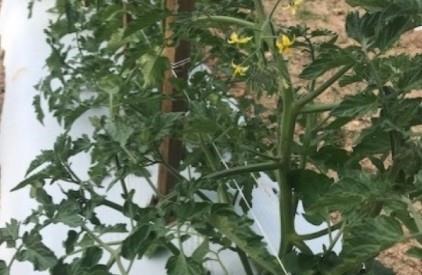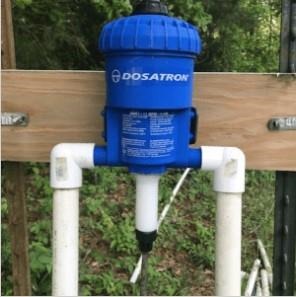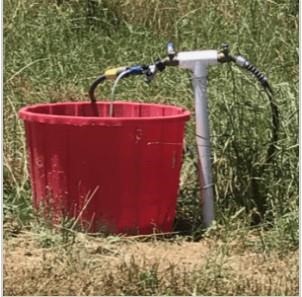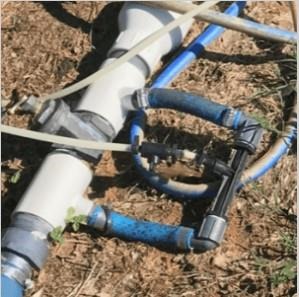Irrigation and fertilization are two of the most important components of growing vegetable crops. When these components are combined, the result is known as fertigation. Fertigation is the process of directly applying fertilizer to a crop through the irrigation system.
In commercial production, drip tape is often used to irrigate vegetable crops. This can be installed either beneath plastic mulch or on the surface of the soil. Drip irrigation allows for precise application of water to the root zone of the crop. Utilizing the drip irrigation system will allow for the same precision when applying water-soluble fertilizers. In most systems, an injector will dispense the proper amount of concentrated fertilizer solution into the drip irrigation system.
Advantages of Fertigation
The ability to continually apply the optimum amount of nutrients required. Fertilizers applied by side dressing are often susceptible to leaching due to excessive amounts applied. Utilizing fertigation eliminates this issue by applying smaller amounts more frequently.
Ease of application. The irrigation system and the injector do the work for you. The grower simply needs to measure the specific amount of fertilizer and mix together the solution.
Less is more. By applying fertilizer directly to the plant and eliminating waste to row middles or leaching, growers can use less product and still achieve optimum yields.

Equipment
The types of injectors used in vegetable production include water-powered piston (diaphragm pumps), pressure differential (Venturi type), or externally powered pumps. A proper irrigation system should include a backflow preventer and filters. Backflow preventers (check valves) should be located between the water source and the injector to prevent any chemicals from reaching the water source. Filters are between the injector and the drip tape to help alleviate any clogging issues of the system. Growers have the option to fertigate during every irrigation cycle, only once per week, or as needed. The frequency is due to soil type and the specific crop.

Water-powered piston pumps are very accurate and often used in greenhouse and small acreage operations.

Pressure differential pumps are easy to install and relatively inexpensive compared to other pumps.

Pressure differential pumps are easy to install and relatively inexpensive compared to other pumps.
Fertilizers
Water-soluble fertilizers are mixed with water to form a solution in a clean container, often a large bucket or drum. The injector uses a siphon tube to inject the solution into the water line that supplies the drip tape. The irrigation system should be operating at full capacity before the injector is activated. Once all fertilizer solution is dispersed, clean water should be distributed throughout the system to flush out all fertilizer. Fertilizer residue left in the drip tape can clog emitters. It is best to inject the fertilizer towards the end of the irrigation event.
Pre-mixed fertilizer – such as 4-0-8, 7-0-7, 10-0-10, and others – can also be used. However, the calculation to determine how much fertilizer needed is based on the products weight per gallon. Fertigation calculators are available for these products or any other product such as the one by Clemson Cooperative Extension.
Fertilizer schedules for individual crops –such as tomatoes, peppers, eggplant, summer squash, small melons, and watermelons– can be found in the Southeastern U.S. Vegetable Crop Handbook. This handbook provides recommendations for daily nitrogen and potassium requirements per acre. These schedules assume that the precise portion of nitrogen, potassium, and other necessary nutrients due to a soil test are included. Rates are adjusted based on the growth stage of the crop. Make sure to calculate the correct amount of fertilizer to inject throughout a given area. Fertilizer rates can be adjusted based on results of a soil analysis.
Calculation Example
The recommendation for newly transplanted tomatoes is .5 pounds of nitrogen per acre per day. If tomatoes are planted on 6 feet rows, then there are 7,260 row feet per acre.
43,560 square ft/acre ÷ 6 ft = 7,260 row feet/acre
If calcium nitrate (15.5-0-0) is used as the fertilizer source, 3.22 pounds of product will be needed per acre.
.5 lb N/acre/day ÷ .155 = 3.22 lbs calcium nitrate/acre/day
If a grower had 1,000 row feet to fertigate, .44 pounds of product would be needed to deliver .5 pounds of nitrogen per acre.
3.22 lbs ÷ 7,260 ft = .00044 lbs
.00044 lbs x 1,000 ft = .44 lbs calcium nitrate
If the fertilizer were only going to be applied once per week to 1,000 row feet, 3.10 pounds of calcium nitrate would be needed.
.44 lbs x 7 days = 3.10 lbs calcium nitrate/week
Source : aces.edu